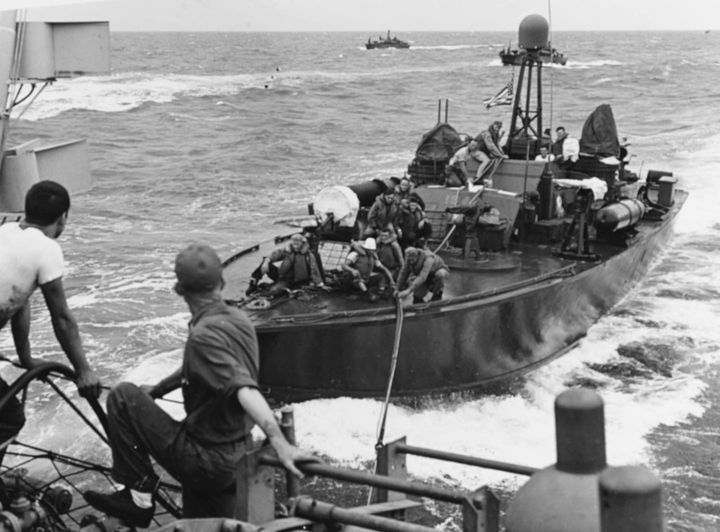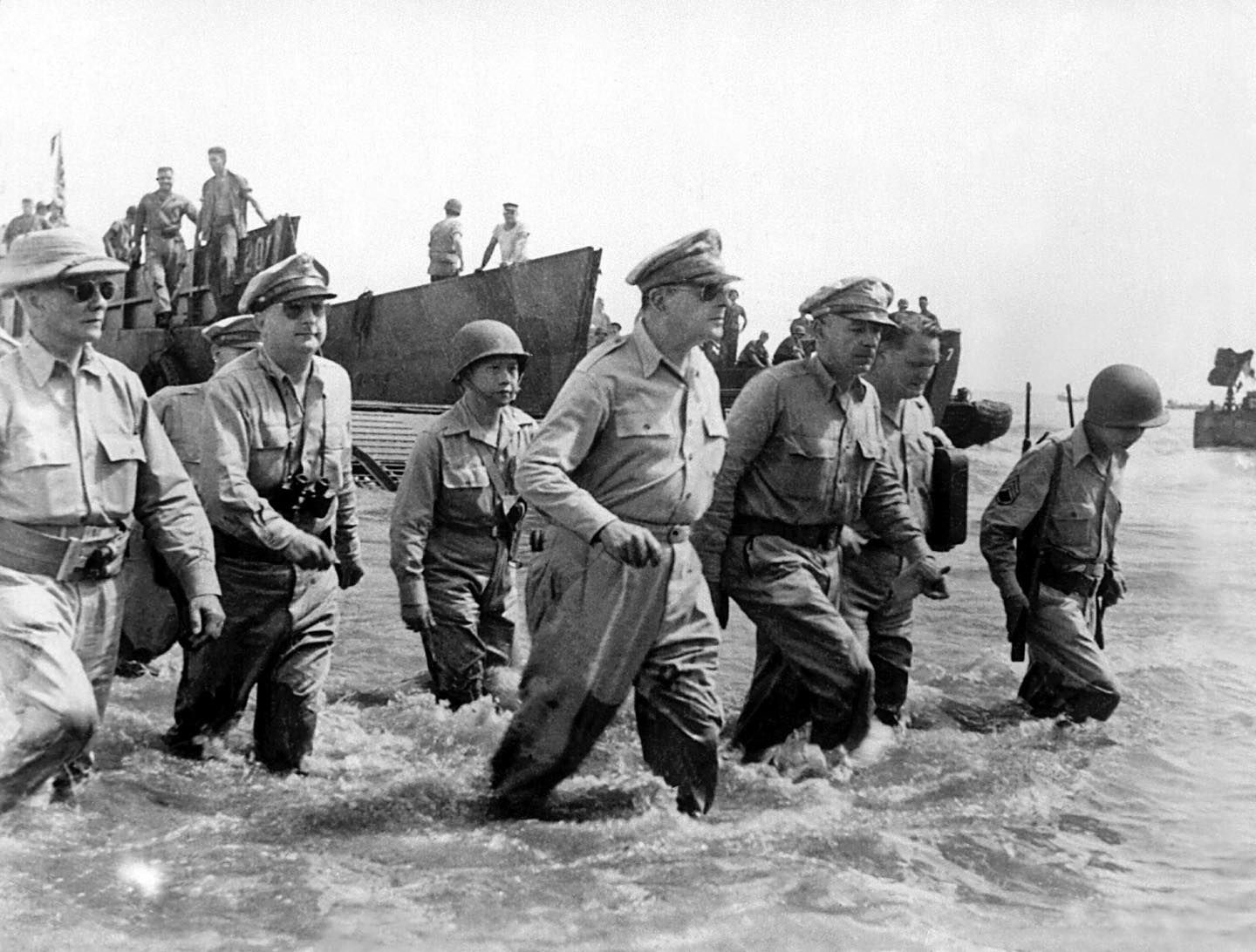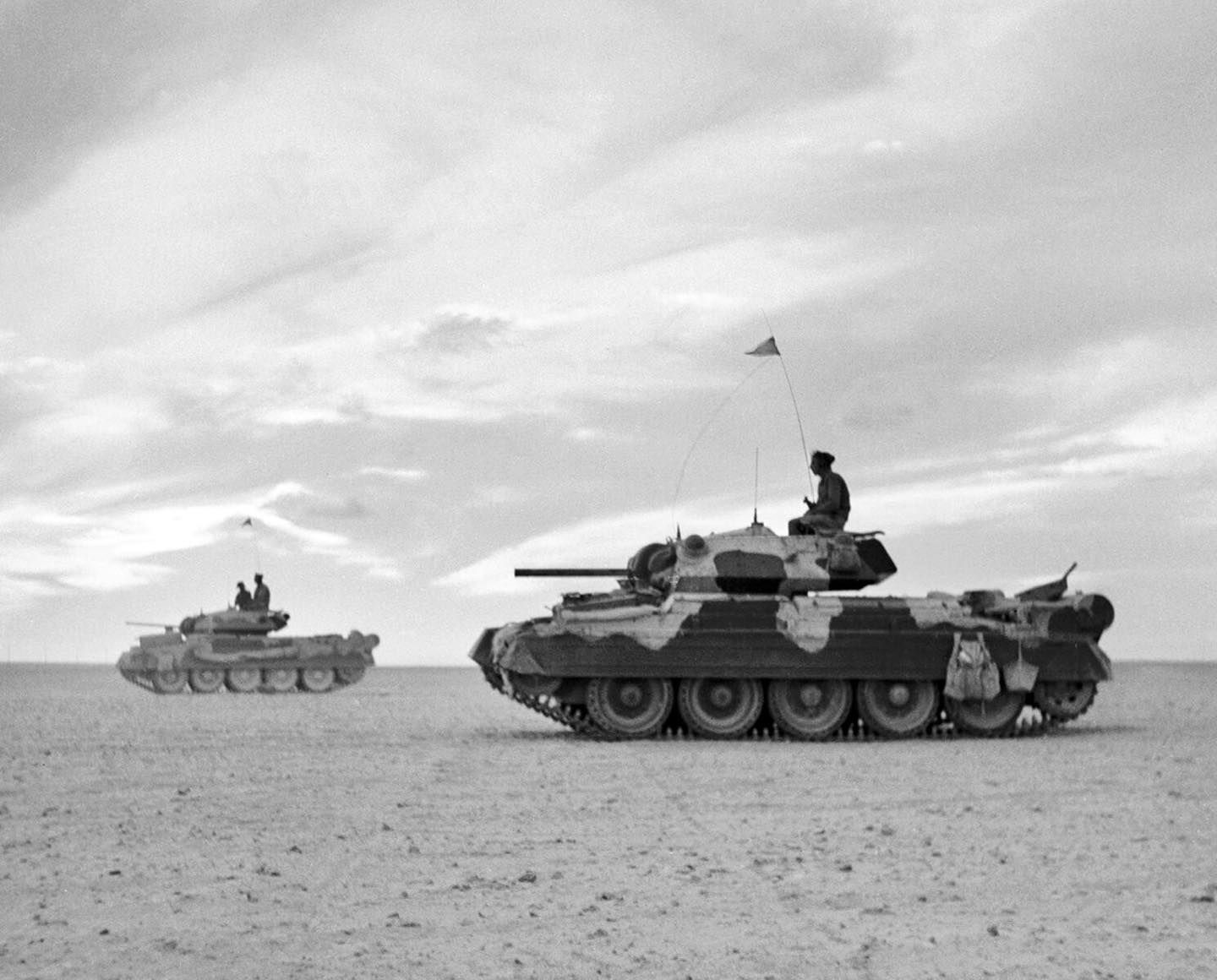I think Japan still would have invaded the Soviet Union though, if the Second Sino-Japanese War continued (the oil embargo only really happened once they invaded Indochina).
Other than that I agree with you. That would be curious alternate reality.
It’s the 80th anniversary of the US landings at Leyte. Almost to Leyte Gulf…
PT-194 refueling from the PT Boat Tender USS Wachapreague AGP-8 while enroute from Palau to Leyte Gulf - October 20, 1944
PT-194 was an 80’ Elco launched in February 1943, assigned to MTBRon 12 in the Pacific, she participated in the Guadalcanal Campaign, New Guinea, Leyte Gulf, and the Battle of Surigao Strait.
PT-194 was stripped and burned at Samar in October 1945….

80 Years Ago Today - US General Douglas MacArthur wades ashore during the initial landings at Leyte in the Philippines - October 20, 1944
In his prepared speech, MacArthur said;
People of the Philippines: I have returned. By the grace of Almighty God our forces stand again on Philippine soil—soil consecrated in the blood of our two peoples. We have come dedicated and committed to the task of destroying every vestige of enemy control over your daily lives, and of restoring upon a foundation of indestructible strength, the liberties of your people.
NARA - US Army Signal Corps
Gaetano Faillace Photographer

Cool!
And so begins my ongoing coverage as the 80th anniversary of the Battle of Leyte Gulf approaches:
October 22, 2024 is the 80th anniversary of when most the Japanese fleet embarked for Opeeration Sho-go 1 set sail towards the Phillipines to counter American landings there.
The ships sailed in multiple seperate task forces from different places, with the Center Force, the most powerful of the fleets and containing battleship legends Yamato and Musashi, led by Vice Admiral Takeo Kurita, and the Southern Force, composed of Force C which included the battleships Fuso and Yamashiro and led by Vice Admiral Shoji Nishimura, departing from Brueni Bay in Borneo that day (likely where a good amount of Japan’s oil supplies were kept). Vice Admiral Kiyohide Shima’s Second Striking Force, consisting exclusively of cruisers and destroyers, left the Pescadores, Formosa the same day.
Vice Admiral Jisaburo Ozawa’s carrier force sortied from the Japanese Home Islands two days earlier, in a fleet consisting of the carrier-battleships Ise and Hyuga and 4 mostly empty carriers, including Zuikaku, the only fleet carrier in the group and the last surviving carrier from the Attack on Pearl Harbor.
Stay tuned for more coverage tommorow as the battle officially starts.
Today is the 80th anniversary of what some call the “Fight of Palawan Passage”, a submarine action at that passage (some people don’t use the term “battle”).
While Kurita’s Center Force was transiting past Palwan Island off the very western parts of the Phillipines, the fleet was attacked by the American submarines Darter and Dace, sinking two Japanese heavy cruisers, the Maya and Kurita’s flagship Atago, and heavily damaging the heavy cruiser Takao enough to force it to retire to Singapore.
Kurita was forced to transfer to the Yamato and make it his command ship.
October 24, 2024. The 80th anniversary of the Battle of Leyte Gulf continues.
After Kurita’s Center Force was spotted by American aircraft, William Halsey’s Fast Carrier Task Force readied an air strike. However, the fleet was caught out of position, with its most powerful carrier group, with 40% of its aircraft, under Vice Admiral John S. Mccain (yes, grandfather of that Mccain), heading back to Ulithi for a refit, while the carrier group closest to the Japanese fleet, under Rear Admrial Gerald F. Bogan, happened to be the weakest of the carrier groups, with only 1 Essex class fleet carrier and 2 Independence class light carriers.
Before American aircraft could strike, however, Japanese aircraft from land bases in the Phillipines attacked the American forces. Poorly trained and outnumbered, most of them were shot down without causing any damage. However, a single D4Y3 Judy torpedo bomber managed to pass through all the defenses, hitting the light carrier Princeton with a 250kg armor piercing bomb. The bomb managed to hit the area where multiple loaded torpedo bombers and many loose torpedos and bombs were stored, causing a catastrophic explosion. Princeton would be the only Independence class light carrier sunk during the Pacific War.
American air strikes on the Japanese fleet were more successful, heavily damaging the heavy cruiser Myoko, forcing it to retire, and landing at least 17 bombs and 19 torpedos on the Yamato class battleship Musashi, sinking it. In response, Kurita turned his fleet around to escape the air range of American aircraft.
Believing the Japanese Center Force to be in retreat, when Halsey’s scouts spotted Ozawa’s carrier-based Northern Force (actually a decoy), the entire Fast Carrier Task Force prepared to meet the Japanese fleet.
Unfortunately, Halsey sent a vague communication to other fleets, making it seem as if he had already formed Task Force 34 (centered around the Fast Carrier Task Force’s fast battleships, including 2 Iowa-class battleships) to guard the San Bernardino strait, the area which the Center Force tried to cross, when his was not the case (he actually meant that Task Force 34 will be formed in the future when ordered by him). This led the commander of the Seventh Fleet (in charge of the amphibhious landings), Vice Admiral Thomas C. Kinkaid, to station all of his Standard-class battleships (probably used for shore bombardment before the battle) to guard Surigao Strait, leaving only a small force of destroyers, destroyer escorts, and escort carriers to guard San Bernardino Strait while Halsey rushed northwards with all of his carriers and fast battleships.
In case you were wondering, Nishiruma’s Southern Force continued sailing to Surigao Strait, but didn’t engage in any combat (yet).
Composite Sherman Tanks of the 1st Cavalry Division prepare to move out while locals chat with US soldiers after being freed from Japanese occupation in Tacloban, Leyte, Philippines - October 24, 1944
Composite Shermans consisted of a cast front section attached to a welded rear section
LIFE Magazine Archives

apanese Battleship Musashi down by the bow after being attacked by US Navy carrier aircraft during the Battle of the Sibuyan Sea - October 24, 1944
Despite Japanese attempts to save her, Musashi capsized and sank, she had been hit by an estimated 19 torpedoes & 17 bombs.
Captain Inoguchi Toshihira chose to go down with his ship, 1,376 of Musashi’s 2,399 crew were rescued.
Lieutenant Tobei Shiraishi Photographer
US Naval History and Heritage Command

These horses look very weird! Almost like tanks…
Nice picture.
October 25! Definitely the climax of the battle. October 25, 2024 is the 80th anniversary of the Battles of Samar, Surigao Strait, and Cape Engano, all the most important components of the battle.
Let’s start with Surigao Strait.
During nighttime on October 24-25 (i.e 22:36 October 24 to dawn on October 25), Vice Admiral Nishiruma’s Southern Force began entering Surigao Strait. Unfortunately, Vice Admiral Kinkaid’s Seventh Fleet had positioned a large number of forces in the area, forcing Nishiruma to run through a gauntlet of withering American attacks as he passed through the strait.
First, he had to pass through a concentrated torpedo nighttime attack by 28 destroyers and 39 torpedo boats stationed on either side of the strait, then face a line of 6 American battleships (5 of which damaged or sunk in the Attack on Pearl Harbor) and cruisers at the end of the strait crossing his T.
Despite emerging unscathed from the PT boat attacks, the Southern Force was annihlated by the American battleships, cruisers, and destroyers, with the battleship Fuso quickly being destroyed. While the American advantage in fire control helped immensely in targeting and sinking the Japanese ships, although due to its gunnery radar being less advanced, the battleship Pennsylvania was unable to locate anything and did not shoot. The battleship Mississippi fired the final battleship salvo against Yamashiro, being the last time a battleship would fire a salvo against another battleship in history.
After the battleship Yamashiro and 3 more destroyers were sunk (taking Nishiruma to a watery grave), the last two ships, the heavy cruiser Mogami and the destroyer Shigure turned and fled as fast as possible.
Around this time, Vice Admiral Shima’s Second Striking Force arrived at Surigao Strait. Upon seeing the destroyed remnants of Nishiruma’s fleet, he quickly ordered his ships to flee, with one of his heavy cruisers colliding with the Mogami, sinking the latter (Shigure would make it out alive, the legendary survivor).
Meanwhile, Kurita’s Center Force emerged out of San Bernardino Strait off the island of Samar, aiming to destroy the American transports landing at Leyte (this was actually also the goal of the Southern Force, but they obviously did not succeed). Because Kinkaid mistakenly thought Halsey left the Fast Carrier Task Force’s battleships to guard the straits when he didn’t, Kurita only encountered a set of escort carrier groups screened by a few destroyers and destroyer escorts, the first being Taffy 3 (Taffy 2 and Taffy 1 were further south). These escort carriers were mostly equipped for land attacks and anti-submarine warfare, almost entirely lacking the torpedos needed to sink the large battleships and cruisers the Japanese had.
Despite being outgunned, outmanned, outnumbered and outplanned, Taffy 3 made an all out stand, launching as many aircraft as possible and sending their escorting ships on suicidal charges, which validated Kurita’s initial belief that he was actually encountering Halsey’s carriers and battleships. Due to strict radio silence Kurita was never informed that the Japanese deception operation had succeeded. His order for a “General Attack” inflicted further chaos on the situation, with his ships becoming uncoordinated with each other.
This was the only time the Yamato (or any ships in its class, for that matter) would fire its massive guns at a surface target, helping sink the escort carrier Gambier Bay. 2 American destroyers and 1 destroyer escort were also sunk by Japanese ships, while the American sank the Japanese heavy cruisers Chokai, Suzuya, and Chikuma (unbelievably dismal for the Japanese given the situation, I might add).
In the end, Kurita, still believing that the Japanese plan failed, withdrew, sparing the American transport fleet. However, Taffy 3’s battle wasn’t over yet.
A set of Special Attack Forces launched the first two strikes in the history of the Pacific War, causing severe damage to two of Taffy 1’s escort carriers and sinking the escort carrier St. Lo from Taffy 3, as well as damaging the escort carriers White Plains, Kitkun Bay, and Kalinin Bay
During all of this (yes, a very busy day), the Fast Carrier Task Force launched 527 sorties against Ozawa’s Northern Force, sinking the fleet carrier Zuikaku (the last surviving member of the Pearl Harbor attack force) along with the light carriers Chitose and Zuiho, while the small force of Japanese planes that attacked beforehand (predictably) scored no hits. Task Force 34 was finally formed, but to close on the Northern Force after air strikes crippled it.
However, as the Battle Off Samar was raging, Halsey began recieving numerous, frantic calls for help from both Nimitz and and Kinkaid, but only after 3 hours did he order Task Force 34 to move southwards. A further delay of 2 and a half hours was spent refilling the task force’s destroyers, preventing them from intervening in the events off Samar in any meaningful way, even after Task Force 34.5, centered around the 2 fastest battleships in the fleet, Iowa and New Jersey, to charge at over 30 knots, was formed.
By the time Task Force 34.5 reached the exit of the San Bernadino Strait, they were only able to sink the Japanese destroyer Nowaki.
Concurrently with Task Force 34’s journey, a small force of cruisers and destroyers detached from it under Rear Admiral Dubose helped sink the light aircraft carrier Chiyoda, already crippled from air strikes earlier that day. Had they encountered Ozawa’s two battleships, Ise and Hyuga, the Americans may have been outgunned, but despite their efforts, the Japanese were unable to locate them.
Funnily enough, during Nimitz’s calls to Halsey for aid to the Seventh Fleet, he insterted as code padding (designed to confuse cryptographers) a loose quote from the famous poem “Charge of the Light Brigade”, as it was then the 90th anniversary of the battle the poem was based on, which means today also makes the 170th anniversary of the Battle of Balaklava.
Tune in tommorow when we wrap up this gargantuan battle!
@SuperbattleshipYamato what a fantastic post; thank you very much. Greatly appreciated.
Thank you so much!
October 26, 2024 is the 80th anniversary of the end of the Battle of Leyte Gulf. I’ll also be covering a few events that happened in the days afterward that were still connected to Leyte Gulf.
By this point, most of the fighting had ended, with the only event being the light cruiser Tama from the Northern Force, already crippled by Halsey’s airstrikes, being sunk by an American submarine (actually this took palce at 23:10 on October 25, but it’s close enough).
Overall, the Japanese experienced greater losses in the battle than the Americans, having lost 3 battleships, 1 fleet carrier, and 3 light carriers amongst others. The US Navy lost no ships bigger than the light carrier.
By the end of it, of the surviving battleships, only the Yamato, Haruna, Ise, and Hyuga were still battleworthy, with the Nagato and Kongo needing repairs.
The battle was a catastrophic loss for the IJN, as the failure to prevent the Americans from liberating the Phillipines meant that Japanese oil supplies would be cut off, preventing most of the surviving ships from being used in any significant way (this reasoning was actually why the Japanese head of the Combined Fleet, Soemu Toyoda, launched the attack in the first place despite the odds).
With the exception of Operation Ten-Go, which saw the Yamato and most of her supporting ships annihilated by American aircraft, the IJN’s surface ships would spend the rest of the war either as floating anti-aircraft batteries (the fate of most of the damaged larger ships), with the ones stationed in the home islands destroyed by American airstrikes on Japanese ports, or convoy missions, where many were sunk by American aircraft and submarines around the Phillipines later in the campaign (this fate awaited most of the Japanese destroyers). Whatever carriers Japan had left would be relegated to aircraft transports.
By the end of the war, with the Kongo sunk by an American submarine and the Ise, Hyuga, and Haruna destroyed in a large American attack at Kure’s naval base, the Nagato would become the only Japanese battleship still afloat (itself expended in US nuclear tests later in the 1940s).
The sole survivor of the Southern Force, the destroyer Shigure, already known for its incredible luck (alongside Yukikaze) surviving brutal battles, ultimately met its match when sunk by an American submarine early in 1945.
Halsey’s mistakes that nearly led to disaster would lead to heavy criticism, although his status meant that he would continue co-leading the war effort against Japan (alongside Spurance) in charge of the Fast Carrier Task Force.
Kurita’s retreat during the Battle of Samar led to criticism by the Japanese high command for not fighting to the death not too different from Gunichi Mikawa’s retreat during the Battle of Savo Island in 1942, where after inflicting lopsided losses during night surface combat, withdrew before he could destroy the transports landing at Guadacanal. Kurita was reassigned to an unimportant position, but would defend his withdrawal for the rest of his life, claiming he did it to save the lives of his men, having long believed the war was lost. He died in 1977.
Decades later, in 1975, Austrian historian Helmut Pemsel would determine by a semi-objective grading system that the Battle of Leyte Gulf was the largest naval battle of all time.
After 80 years, the Battle of Leyte Gulf still inspires countless what ifs and speculation and the stories of Kurita and Halsey continue to inspire people (mostly just me).
S Navy Sailors, survivors of the Battle off Samar the previous day, are rescued by a USN ship - October 26, 1944
Some 1,200 survivors of Gambier Bay CV 73, USS Hoel DD 533, USS Johnston DD 577, and USS Samuel B. Roberts DE 413 were rescued during the days following the action.
US Army Signal Corps - SC-278010
Pvt William Roof Photographer

Nice.
British Crusader tanks at sunset during the Battle of El Alamein in North Africa - October 27, 1942
IWM - Silverside, John (Sgt) Photographer
IWM E 18642

Oct 27 1942 the USS Hornet sinks during the battle of Santa Cruz. Picture is a Val dive bomber crashing into Hornet during the battle.
By U.S. Navy - U.S. Navy photo [1]/[2] from Hyperwar, Public Domain, https://commons.wikimedia.org/w/index.php?curid=879041